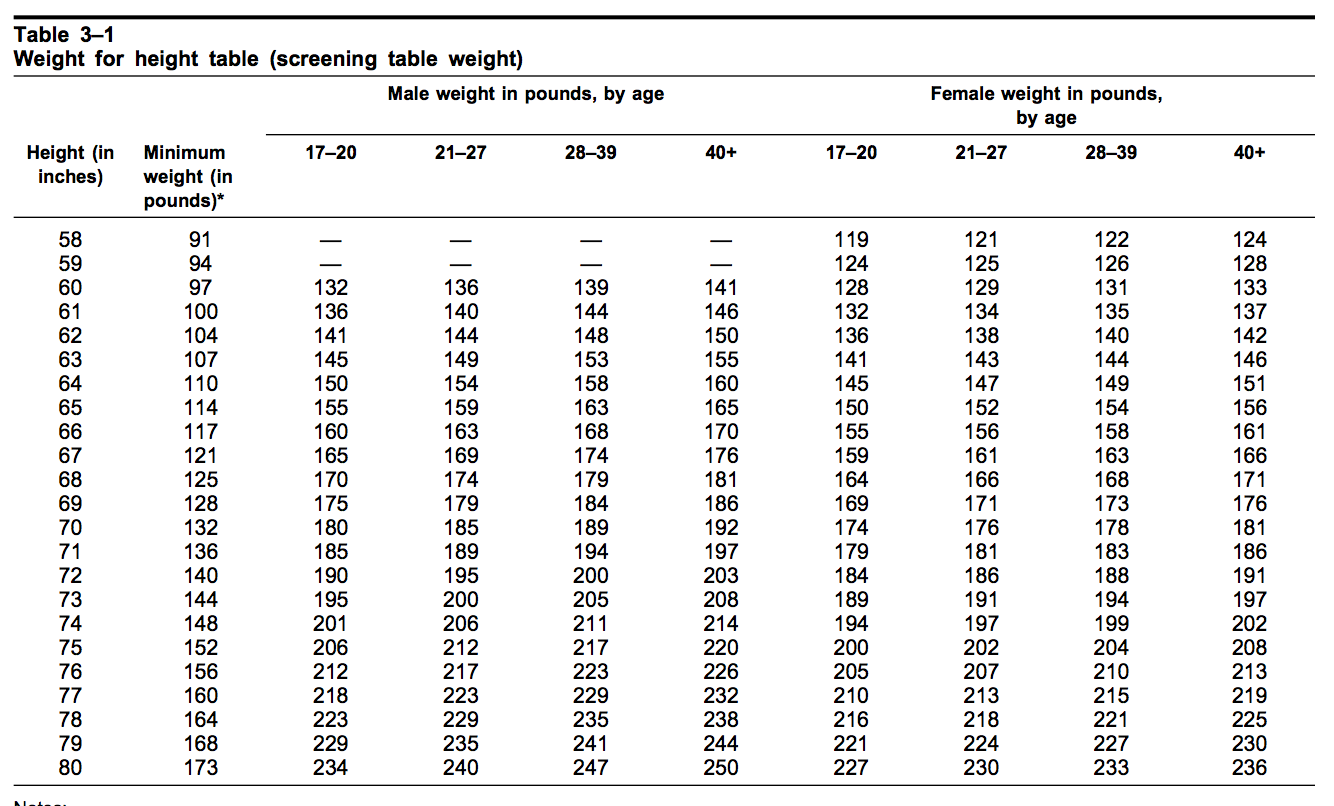Army weight standards are crucial for maintaining a fit and ready military force. These standards ensure that all personnel meet the physical requirements necessary for the demands of military service. In this article, we will explore the various aspects of army weight standards, including what they entail, how they are measured, and their importance in maintaining operational readiness.
The military's commitment to physical fitness is not just about individual health; it's about ensuring that every soldier can perform their duties effectively. Understanding the army weight standards is essential for current and prospective service members, as well as for families who support them. This comprehensive guide will delve into the specifics of these standards, providing valuable insights and practical information.
From the implications of weight standards on enlistment and retention to the methodologies used in assessing body composition, this article will cover all facets of army weight standards. Whether you're a soldier, a recruiter, or simply interested in military fitness, this guide will provide you with the knowledge you need.
Table of Contents
- What Are Army Weight Standards?
- Importance of Army Weight Standards
- Measurement Techniques for Weight Standards
- Understanding Body Composition
- Weight Standards by Age and Gender
- Consequences of Not Meeting Standards
- Tips for Meeting Army Weight Standards
- Conclusion
What Are Army Weight Standards?
Army weight standards are specific guidelines that determine the maximum allowable weight for soldiers based on their height and gender. These standards are designed to ensure that all service members maintain a healthy body weight that correlates with their physical readiness to perform military duties.
The Army uses a combination of weight and body fat percentage to assess a soldier's physical fitness. If a soldier exceeds their allowable weight, they may be required to undergo further assessments to evaluate their body composition.
Importance of Army Weight Standards
The importance of army weight standards cannot be overstated. They serve several critical functions, including:
- Operational Readiness: Soldiers must be physically fit to carry out their duties effectively, especially in high-stress environments.
- Health and Safety: Maintaining a healthy weight reduces the risk of injuries and health issues associated with being overweight.
- Team Cohesion: A physically fit army promotes a sense of unity and discipline among soldiers.
Measurement Techniques for Weight Standards
The Army employs various measurement techniques to assess weight and body composition:
1. Weight Measurement
Soldiers are weighed regularly to ensure compliance with weight standards. Weight is typically measured in uniform conditions to maintain consistency.
2. Body Fat Assessment
If a soldier exceeds the weight limit, they may undergo body fat assessments using methods such as:
- Skinfold measurements
- Bioelectrical impedance analysis
- Waist circumference measurements
Understanding Body Composition
Body composition refers to the proportion of fat and non-fat mass in a person's body. The army emphasizes the importance of body composition over weight alone, as muscle mass can influence overall weight without negatively impacting health.
Soldiers are encouraged to focus on improving their body composition through a combination of diet, exercise, and lifestyle modifications.
Weight Standards by Age and Gender
Army weight standards vary by age and gender, acknowledging the differences in body composition among soldiers. Here are the general weight standards:
| Age Group | Male Weight Standard | Female Weight Standard |
|---|---|---|
| 17-20 | Maximum 163 lbs | Maximum 140 lbs |
| 21-27 | Maximum 175 lbs | Maximum 145 lbs |
| 28-39 | Maximum 185 lbs | Maximum 150 lbs |
| 40+ | Maximum 196 lbs | Maximum 160 lbs |
Consequences of Not Meeting Standards
Failure to meet army weight standards can lead to several consequences, including:
- Mandatory Weight Management Programs: Soldiers may be required to participate in programs aimed at reducing weight.
- Impact on Promotions: Non-compliance can affect a soldier's eligibility for promotions and certain assignments.
- Potential Separation: Continued failure to meet standards may lead to administrative action and separation from service.
Tips for Meeting Army Weight Standards
Meeting army weight standards requires dedication and effort. Here are some practical tips:
- Maintain a Balanced Diet: Focus on nutrient-rich foods and control portion sizes.
- Regular Exercise: Incorporate both cardiovascular and strength training exercises into your routine.
- Stay Hydrated: Drink plenty of water to support metabolism and overall health.
- Seek Support: Join a fitness group or seek guidance from a nutritionist or personal trainer.
Conclusion
In conclusion, understanding army weight standards is essential for all service members. These standards not only promote individual health but also ensure that the military remains operationally ready. By adhering to the guidelines set forth, soldiers can enhance their performance and contribute to the overall effectiveness of their units.
If you found this article informative, please leave a comment below, share it with others, or explore more articles on our site to learn about military fitness and standards.
Thank you for reading! We hope to see you back on our site for more insights and information.
You Might Also Like
Daniel Craig Biography: The Journey Of A Hollywood IconUnderstanding Jessica Kirson's Family: A Deep Dive Into Her Life And Legacy
Is John Heilman Married? Unveiling The Personal Life Of The Political Commentator
Sawyer Sweeten Net Worth: A Comprehensive Analysis
Carley Shimkus: A Comprehensive Look At The Fox News Anchor
Article Recommendations
- Jonah Hill Sarah Brady Text Messages Full Transcript 1812193
- Joe Alwyn Posts Brooding Photo After Taylor Swift Cozies Travis Kelce 1950189
- New Jersey Map Population Shifting Crowded 1975080
- Tiffany Gomas Not Real Tiktok Video Ultra Right Beer Photo 1891657
- Rainbow Bridge Closure What We Know 1846195
- Little Rascals Netflix Where Are They Now 2021 1582862
- Sweatpea Owner Speaks About Dog Honored During 2024 Puppy Bowl 1869279
- Donald Trump Calls Jd Vance Town Hall Michigan 1974861
- Mel Gibson Anti Semitism Racism Accusations 1512808
- What Pamela Anderson Has Said About Sex Tape Tommy Lee Pamela Love Story Netflix 1776828


